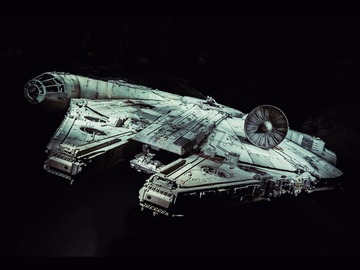The old is the new in the latest Star Wars movie, with a return to the original storyline and a back-to-basics (well, multi-million dollar basics) approach to filming real practical effects and less dependence on CGI.

The specific language of the original Star Wars is successful for the same reason that its visual universe is coherent: a mix of the familiar and the new. Whereas 2001, Star Trek, and Space: 1999 showed only gleaming white, clean spaceships, Star Wars showed us something that seemed both strikingly original and intuitively right: old and beat-up spaceships and robots along with junk and clutter familiar to anyone who has a garage.
The arc of the story resonated easily with audiences because George Lucas mixed the old and the new in perfect proportions. From his sources of movie inspiration (like Flash Gordon, Buck Rogers, and westerns) to his love of midcentury car culture (celebrated in his earlier film American Graffiti) to his use of archetypal myth and comparative religion, the plot was familiar enough that the imaginative new specifics were details, not distractions.
The same is true for the famous John Williams score. Whereas Star Trek went for the otherworldly with its theremin-like female vocal, the music from Star Wars, like the film itself, was a compelling blend of pastiche and fresh ideas, wrapped in big symphonic orchestrations that borrowed heavily from Tchaikovsky, Dvorak, and Holst. And the costumes, too: no sleek bodysuits in this space movie. Instead, Obi-Wan wore a monk’s robe and the Imperials wore barely disguised World War II German uniforms, up to and including Darth Vader’s helmet.
And so with language: stormtrooper taps into terrifying chapters of 20th-century history from its use in World War I for Germany's shock troops and later for Nazi paramilitaries. Bounty hunter comes straight from the westerns that inspired Lucas, if not the Wild West itself, since the term used in this way only dates back to the early 1950s.
Death Star, lightsaber, landspeeder, sand people, star destroyer, moisture farm, power converters, bowcaster, sandcrawler, tractor beam, the dark side, and Millennium Falcon are made up of familiar parts. Existing terms like light speed, blaster, knight, Rebellion, and Imperial were used for important story elements. Luke uses meter as a unit of measure. And droid shows brilliant faux linguistic aging of the shortening of a familiar word (android), which sometimes happens when they become quotidian and familiar; think of bus from omnibus.
These terms don’t distract us like the made-up phaser or warp speed or tribble (in Star Trek) or centon (a unit of time in Battlestar Galactica). Of course places and creatures require imaginative new names in science fiction, but while Klingon and Vulcan were central to the Star Trek narrative, similar invented names like Corellian, bantha, or womp rat are words of secondary importance in the Star Wars universe. Even in this category Lucas took much inspiration from reality: Wookiee came from the name of a real person and Tatooine was named for a Tunisian town, Tataouine.
Lucas named the most powerful element in his film with a perfectly ordinary word: the Force. The use of the Force as a pseudo-religion is further underscored by the somber salutation "May the Force be with you," an echo of the kiss of peace in the Catholic Mass (“peace be with you”), with its vaguely archaic and ceremonial subjunctive.
This very grounded use of language plays a big role in giving Star Wars a ring of truth. Even if parsec is really a measure of distance, not time.





